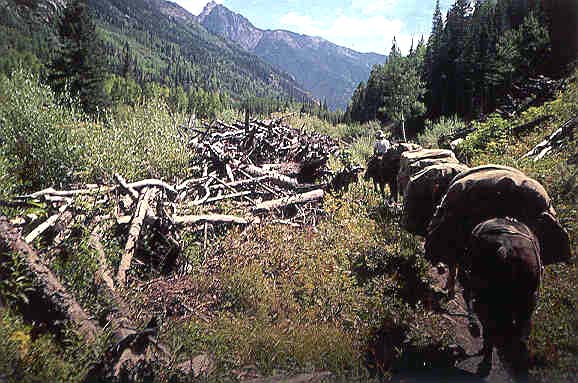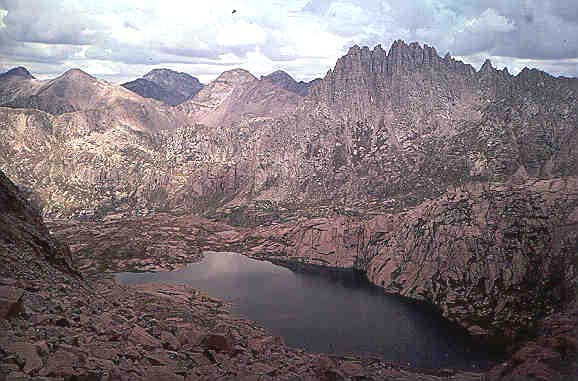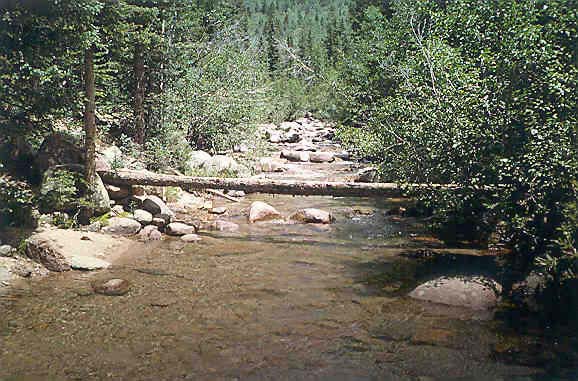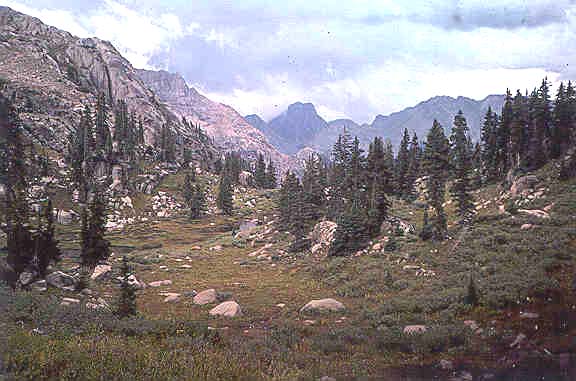Hydrologic Benchmark Network Stations in the West-Central U.S. 1963-95 (USGS Circular 1173-C)
|
|
|
|
|
Vallecito Creek near Bayfield, Colorado (09352900)
Hydrologic Benchmark Network Stations in the West-Central U.S. 1963-95 (USGS Circular 1173-C)
|
|
|
|
|
Vallecito Creek near Bayfield, Colorado (09352900)
To download a printer friendly PDF version of this information click here.
This report details one of the approximately 50 stations in the Hydrologic Benchmark Network (HBN) described in the four-volume U.S. Geological Survey Circular 1173. The suggested citation for the information on this page is:
|
Clark, M.L., Eddy-Miller, C.A., Mast, M.A., 2000, Environmental characteristics and water-quality of Hydrologic Benchmark Network stations in the West-Central United States, U.S. Geological Survey Circular 1173-C, 115 p. |
All of the tables and figures are numbered as they appear in each circular. Use the navigation bar above to view the abstract, introduction and methods for the entire circular, as well as a map and list of all of the HBN sites. Use the table of contents below to view the information on this particular station.
|
Table of Contents |
| 1. Site Characteristics and Land Use |
| 2. Historical Water Quality Data and Time-Series Trends |
| 3. Synoptic Water Quality Data |
The Vallecito Creek HBN Basin is in the Southern Rocky Mountains physiographic province (Fenneman,
 |
Vallecito Creek is a perennial stream that originates at high altitude within the drainage at Vallecito Lake. The creek flows southward, draining several high mountain lakes and streams and ending in Vallecito Reservoir. On the western side of the basin, Vallecito Creek drains the eastern slope of the Needles Mountains. The basin has a snowmelt-dominated hydrograph with mean monthly discharges that range from 0.57 m³/s in February to 15 m³/s in June (Crowfoot and others, 1996b). The climate of the basin is variable and is generally related to the large changes in elevation. Climatic data are recorded at the Vallecito Dam weather station in the lower basin, about 13 km southwest of the HBN station. The Vallecito Dam weather station receives an average of 67 cm of precipitation annually, whereas annual precipitation in the upper basin is about 130 cm. About 80 percent of the precipitation in the upper basin occurs as snow (Cobb and Biesecker, 1971), and the average annual runoff is about 70 cm (Crowfoot and others, 1996b). Mean monthly temperatures at the weather station ranged from -5.9×C in January to 17.6×C in July during the period of record, 1948-95 (National Climatic Data Center, 1996). Average temperatures in the upper basin would be less, as temperatures decrease with increasing elevation.
The geology of the basin is characterized primarily by metamorphic and igneous rocks of Precambrian age.
 |
The Vallecito Creek HBN station is in La Plata County. The Vallecito Creek Basin lies entirely within the San Juan National Forest and most of the basin is within the Weminuche Wilderness Area. The only road in the basin skirts the lower part of the basin for about 1 km. Access to the rest of the basin is by foot or horseback on pack trails, as mechanized vehicles are not permitted in the wilderness area. During the winter, access is limited to snowshoes and skis. Because almost all of the Vallecito Creek Basin is preserved as a wilderness area, recreational activities, such as hiking, backpacking, fishing, and hunting trips, are the predominant land use. Winter activities are limited owing to the high avalanche danger in the area (D.W. Grey, U.S. Geological Survey, oral commun., 1997). Historically, a small amount of mining took place in scattered areas throughout the basin, with a concentrated effort near the Columbine Pass area in the Johnson Creek subbasin.
The data set analyzed for the Vallecito Creek HBN station includes 234 water-quality samples that were collected from March 1963 to September 1995. Sampling frequency is described on the basis of water year, which begins on October 1 and ends on September 30. Sampling frequency was highly variable between 1963 and 1972; no samples were collected in 1965 and 1969, and 17 samples were collected in 1972. Sampling frequency generally was between 11 to 17 samples per year during 1971 to 1982. During the mid- to late 1980's and early 1990's, sampling generally was quarterly. Samples were analyzed at USGS district water-quality laboratories until the early 1970's. After 1973, with the creation of the USGS Central Laboratory System, all samples were analyzed at the water-quality laboratory (now called NWQL) in Arvada, Colo. The period of record for discharge is from water year 1963 to current year (2000). Daily water temperature was recorded from November 1962 to September 1982.
 |
Data quality was checked using ion balances and time-series plots. Calculated ion balances for samples with complete major-ion analyses are shown in Figures 5a and 5b. Temporal variation of discharge, field pH, major dissolved constituents, and ion balance at Vallecito Creek, Colorado. More than 90 percent of the samples had ion balances within the ±10 percent range, indicating that the major-ion analytical results were of good quality and that unmeasured constituents, such as organic anions, nutrients, and trace metals, generally do not contribute substantially to the ionic composition of Vallecito Creek. Time-series plots of ion concentrations were inspected for evidence of influences that are related to analytical method changes (fig. 5). Magnesium and sodium show a similar pattern of having more scatter in the early part of the record and a decrease in scatter after 1983. This decrease coincides with a change in the analytical method for these analytes from AA spectroscopy to ICP spectroscopy (U.S. Geological Survey Office of Water Quality Technical Memorandum No. 82.18, 1982). The decrease in scatter of sulfate concentrations after 1982 corresponds with the change from a methylthymol blue procedure to a turbidimetric titration method (U.S. Geological Survey Office of Water Quality Technical Memorandum No. 83.07, 1983). The further decrease in the scatter of sulfate concentrations after 1990 corresponds with the change from turbidimetric titration to an ion-exchange chromatography analytical method (U.S. Geological Survey Office of Water Quality Technical Memorandum No. 90.04-T, 1989; U.S. Geological Survey Office of Water Quality Technical Memorandum No. 90.13, 1990). Distinct temporal patterns also are evident in the field pH determinations. Changes were made in meters and electrodes used for field pH determinations during the study period. When changes in methods or instrumentation result in improved precision or elimination of measurement bias, time-series data can exhibit less scatter or a directional shift, respectively. The time-series data, therefore, may reflect the method or instrument change rather than an environmental change.
The median and range of major-ion concentrations in stream water collected at the Vallecito Creek HBN station and VWM concentrations in wet precipitation measured at the Molas Pass NADP station are presented in table 6. The NADP station is about 35 km northwest of the HBN station. Precipitation chemistry at the NADP station was dilute and slightly acidic with a VWM pH of 5.0 during the period of record, 1986-95. The dominant cation in precipitation was calcium, which contributed about 41 percent of the total cation concentration. The dominant anions in precipitation were sulfate and nitrate, which contributed 47 and 43 percent of the total anion concentration, respectively. Possible sources of the nitrogen species and sulfate in precipitation are smelters, agriculture, and vehicles (National Acid Precipitation Assessment Program, 1993).
[Parameters in units of microequivalents per liter, except for discharge in cubic meters per second, specific conductance in microsiemens per centimeter at 25 degrees Celsius, pH in standard units, and silica in micromoles per liter; n, number of stream samples; VWM, volume-weighted mean; spec. cond., specific conductance; --, not reported; <, less than]
|
Parameter |
Stream Water |
Precipitation VWM |
|||||
|
Minimum |
First quartile |
Median |
Third quartile |
Maximum |
n |
||
| Discharge |
0.05 |
0.74 |
1.9 |
5.2 |
39 |
231 |
-- |
| Spec. cond., field |
33 |
60 |
74 |
85 |
146 |
228 |
-- |
| pH, field |
5.9 |
7.2 |
7.5 |
7.9 |
8.7 |
226 |
5.0a |
| Calcium |
180 |
400 |
500 |
600 |
800 |
233 |
14 |
| Magnesium |
40 |
130 |
160 |
190 |
420 |
234 |
2.0 |
| Sodium |
4.4 |
35 |
48 |
57 |
160 |
231 |
3.0 |
| Potassium |
5.1 |
13 |
15 |
18 |
62 |
232 |
.61 |
| Ammonium |
<.7 |
.9 |
2.1 |
5.0 |
12 |
74 |
4.6 |
| Alkalinity, laboratory |
160 |
420 |
520 |
620 |
860 |
226 |
-- |
| Sulfate |
35 |
140 |
170 |
210 |
540 |
230 |
12 |
| Chloride |
<2.8 |
8.5 |
16 |
28 |
280 |
230 |
2.4 |
| Nitrite plus nitrate |
<.7 |
6.4 |
7.9 |
11 |
50 |
185 |
11b |
| Silica |
38 |
52 |
63 |
70 |
83 |
231 |
-- |
a Laboratory pH.
b Nitrate only.
Stream water in Vallecito Creek is a slightly alkaline, calcium bicarbonate type. The sum of ion
 |
Correlations among dissolved constituents and discharge were determined for Vallecito Creek (table 7). Base cations and anions were inversely correlated with discharge. These results are consistent with a hydrologic system where base-flow chemistry that is dominated by ground water is diluted during periods of increased discharge, particularly during annual snowmelt runoff. Ion concentrations in ground water tend to be greater than in surficial sources because the contact time with rocks and minerals is longer. Among the cations, the strongest positive correlations were between calcium and magnesium (rho = 0.918) and magnesium and sodium (rho = 0.867). Calcium and magnesium also were strongly correlated with alkalinity (rho values = 0.836 and 0.807, respectively) and silica (rho values = 0.873 and 0.807, respectively). These relations are consistent with a geologic setting that is rich in calc-silicate minerals.
[Q, discharge; Ca, calcium; Mg, magnesium; Na, sodium; K, potassium; Alk, alkalinity; SO4, sulfate; Cl, chloride; SiO2, silica; --, not applicable]
|
|
Q |
pH |
Ca |
Mg |
Na |
K |
Alk |
SO4 |
Cl |
| pH |
-0.263 |
-- |
-- |
-- |
-- |
-- |
-- |
-- |
-- |
| Ca |
-.800 |
0.267 |
-- |
-- |
-- |
-- |
-- |
-- |
-- |
| Mg |
-.731 |
.158 |
0.918 |
-- |
-- |
-- |
-- |
-- |
-- |
| Na |
-.680 |
.172 |
.762 |
0.867 |
-- |
-- |
-- |
-- |
-- |
| K |
-.439 |
.036 |
.544 |
.570 |
0.578 |
-- |
-- |
-- |
-- |
| Alk |
-.624 |
.176 |
.836 |
.807 |
.614 |
0.492 |
-- |
-- |
-- |
| SO4 |
-.659 |
.231 |
.711 |
.648 |
.536 |
.348 |
0.521 |
-- |
-- |
| Cl |
-.436 |
.227 |
.471 |
.394 |
.382 |
.396 |
.329 |
0.471 |
-- |
| SiO2 |
-.722 |
.239 |
.873 |
.807 |
.702 |
.589 |
.766 |
.545 |
0.357 |
Results of the seasonal Kendall test for trends in discharge and major dissolved constituents for Vallecito Creek are presented in table 8. A statistically significant upward trend for discharge was detected (p-value = 0.006) from 1970 to 1995. The trend in discharge only is representative of instantaneous measurements made during water-quality sampling and may not correspond with a trend in the continuous discharge record. Positive departures from average precipitation did occur during some years in the latter part of the period of record (Crowfoot and others, 1996b). Statistically significant downward trends were detected for unadjusted concentrations of calcium, sodium, potassium, sulfate, and chloride. Trends in calcium, sodium, and sulfate were not statistically significant in flow-adjusted concentrations. This indicates that the unadjusted trends probably were driven by the upward trend in discharge as these ions all showed inverse correlations with discharge. A downward trend in alkalinity at this station detected during the study by Smith and Alexander (1983) for the period from the mid-1960's to 1981 was not significant for the period 1970-95. The downward trends for potassium and chloride were retained after flow adjustment. Potassium and chloride trends in stream water are consistent with decreasing concentrations of potassium and chloride in precipitation. Precipitation trends of potassium and chloride were observed at five NADP stations in Colorado by Lynch and others (1995) for the period 1980-92; however, the Molas Pass NADP station was not part of their study. After accounting for evapotranspiration, precipitation contributes about 25 percent of the median chloride concentration in stream water, but only about 8 percent of the median potassium concentration. Alternatively, trends in potassium and chloride may be caused by changes in analytical methods that occurred during the period of record.
[Trends in units of microequivalents per liter per year, except for discharge in cubic meters per second per year, pH in standard units per year, and silica in micromoles per liter per year; p-value, attained significance level; --, not calculated; <, less than]
|
Parameter |
Unadjusted |
Flow adjusted |
||
|
Trend |
p-value |
Trend |
p-value |
|
| Discharge |
1.00 |
0.006 |
-- |
-- |
| pH |
<.01 |
.79 |
<0.01 |
0.649 |
| Calcium |
-3 |
.003 |
-2.0 |
.034 |
| Magnesium |
-.8 |
.038 |
-.4 |
.280 |
| Sodium |
-.5 |
<.001 |
-.3 |
.071 |
| Potassium |
-.3 |
<.001 |
-.2 |
<.001 |
| Alkalinity |
-1 |
.320 |
.2 |
.908 |
| Sulfate |
-2 |
<.001 |
-1 |
.011 |
| Chloride |
-.5 |
<.001 |
-.5 |
.002 |
| Nitrite plus nitrate |
<.01 |
.839 |
.01 |
.644 |
| Silica |
<.01 |
.727 |
.01 |
.954 |
Results of surface-water synoptic sampling conducted July 25-27 and August 17, 1990, in the Vallecito Creek Basin are presented in table 9, and locations of the sampling sites are shown in figure 4. Discharge at the HBN station (site 10) was 2.5 m³/s, which is less than the mean monthly discharge of 7.1 m³/s for the month of July (Crowfoot and others, 1996b). Concentrations of dissolved constituents measured in the tributary creeks in the upper basin were generally less than the minimum concentrations of constituents measured at the HBN station for the period 1963-95 (table 6). The sum of ions ranged from about 160 meq/L on Roell Creek (site 6) to 3,700 meq/L on Second Creek (site 9); the sum of ions was 1,100 meq/L at the HBN station (site 10). The percent difference of cations and anions for all samples except site 3 ranged from 0.7 to 5.4 percent, indicating that unmeasured ions did not contribute substantially to the ionic composition of the tributary waters. Site 3 had a cation deficit of 13 percent. This may indicate that unmeasured cations, possibly iron, may contribute to the ion composition of the water. An iron precipitate was observed on the streambed at this site.
[Site locations shown in fig. 4; Q, discharge in cubic meters per second; SC, specific conductance in microsiemens per centimeter at 25 degrees Celsius; pH in standard units; Ca, calcium; Mg, magnesium; Na, sodium; K, potassium; Alk, alkalinity; SO4, sulfate; Cl, chloride; NO3, nitrate; SiO2, silica; concentrations in microequivalents per liter, except silica is in micromoles per liter; --, not measured; <, less than; criteria used in selection of sampling sites: BG = bedrock geology, TRIB = major tributary, LU = land use]
|
Site |
Identification Number |
Q |
SC |
pH |
Ca |
Mg |
Na |
K |
Alk |
SO4 |
Cl |
NO3 |
SiO2 |
Criteria |
|
|
374105107314000 |
<0.03 |
20 |
6.6 |
90 |
66 |
8.7 |
4.4 |
10 |
138 |
2.5 |
5.7 |
27 |
BG |
|
|
374103107313400 |
<.03 |
18 |
6.9 |
75 |
38 |
13 |
5.4 |
53 |
83 |
2.3 |
3.6 |
55 |
BG |
|
|
374038107413400 |
<.2 |
15 |
7.0 |
75 |
35 |
<8.7 |
2.3 |
50 |
67 |
2.5 |
4.3 |
32 |
BG |
|
|
373915107311200 |
<.1 |
58 |
4.8 |
140 |
200 |
13 |
5.1 |
<10 |
480 |
2.8 |
1.4 |
53 |
LU |
|
|
373835107320800 |
-- |
18 |
6.6 |
100 |
39 |
13 |
4.1 |
52 |
100 |
3.1 |
5.7 |
38 |
TRIB |
|
|
373800107322500 |
-- |
20 |
7.6 |
130 |
29 |
17 |
12 |
120 |
52 |
2.3 |
3.6 |
33 |
BG, TRIB |
|
|
373650107321400 |
-- |
9 |
6.9 |
55 |
17 |
<8.7 |
4.4 |
39 |
25 |
3.4 |
12 |
25 |
BG, TRIB |
|
|
373521107320200 |
-- |
30 |
7.3 |
220 |
50 |
30 |
8.5 |
200 |
65 |
4.5 |
8.6 |
48 |
TRIB, LU |
|
|
373423107311700 |
-- |
59 |
7.4 |
440 |
65 |
26 |
20 |
410 |
127 |
4.8 |
16 |
37 |
BG, TRIB |
|
|
373219107312500 |
-- |
158 |
8.4 |
1,200 |
520 |
26 |
17 |
1,800 |
48 |
40 |
7.1 |
50 |
BG, TRIB |
|
|
09352900 |
2.5 |
54 |
7.6 |
380 |
130 |
30 |
13 |
410 |
140 |
4.8 |
5.0 |
52 |
-- |
The water type in three of the upper tributary creeks (sites 2, 2a, and 4) and the upper main stem (site 1) was calcium sulfate. The water type of Rock Creek (site 3) was magnesium sulfate. Streams with these water types generally have little buffering capacity. An abandoned mine, which was identified just upstream from the Rock Creek site (site 3), possibly contributed to the low pH (4.8) and low alkalinity (less than 10 meq/L) measured at that site. The water type in the lower parts of the basin (sites 5, 6, 7, 8, 9, and 10) changes to calcium bicarbonate, owing to the changes of the rock types from the upper to the lower basin. The rock types of the upper basin are dominated by metamorphic slate, phyllite, and quartzite, whereas rock types in the lower basin are predominantly granite and metavolcanics. Second Creek (site 9), which drains Paleozoic rocks, including limestone, had larger concentrations of calcium, magnesium, and alkalinity than other sites more than three times larger than the concentration at the HBN station. Bicarbonate contributed a large percentage of the anion concentration at site 9 (about 95 percent); this resulted in alkaline stream water (pH = 8.4). The buffering capacity of Vallecito Creek increased from slightly acidic (pH = 6.6) in the upper basin (site 1) to slightly alkaline (pH = 7.6) downstream (site 10).
Bailey, Robert G., 1995, Descriptions of the ecoregions of the United States: U.S. Department of Agriculture, Forest Service, Miscellaneous Publication 1391, 108 p.
Barker, Fred, 1969, Precambrian geology of the Needle Mountains, southwestern Colorado: U.S. Geological Survey Professional Paper 644-A, p. A1-A33.
Biesecker, J.E., and Leifeste, D.K., 1975, Water quality of hydrologic benchmarks-An indicator of water quality in the natural environment: U.S. Geological Survey Circular 460-E, 21 p.
Cobb, E.D., and Biesecker, J.E., 1971, The National Hydrologic Benchmark Network: U.S. Geological Survey Circular 460-D, 38 p.
Cross, W., and Larsen, E.S., 1935, A brief review of the geology of the San Juan Region of southwestern Colorado: U.S. Geological Survey Bulletin 843, 138 p.
Crowfoot, R.M., Ugland, R.C., Maura, W.S., Jenkins, R.A., and O'Neill, G.B., 1996b, Water resources data, Colorado, water year 1995-v. 2, Colorado River Basin: U.S. Geological Survey Water-Data Report CO-95-2, 471 p.
Fenneman, N.M., 1946, Physical divisions of the United States: Washington, D.C., U.S. Geological Survey special map, scale 1:7,000,000.
Gonzales, D.A., 1988, A geologic investigation of the early Proterozoic Irving Formation, southeastern Needle Mountains, Colorado: U.S. Geological Survey Open-File Report 88-660, 119 p.
Lynch, J.A., Bowersox, V.C., and Grimm, J.W., 1995, Trends in precipitation chemistry in the United States-A national perspective, 1980-92: Atmospheric Environment, v. 29, no. 11. p. 1231-1246.
National Climatic Data Center, 1996, Summary of the day, CD-ROM: Boulder, Colorado, EarthInfo Incorporated.
National Acid Precipitation Assessment Program, 1993: Washington, D.C., Report to Congress 1992, 130 p.
Smith, R.A., and Alexander, R.B., 1983, Evidence for acid-precipitation-induced trends in stream chemistry at hydrologic benchmark stations: U.S. Geological Survey Circular 910, 12 p.
U.S. Geological Survey, 1982, Program and plan-National water-quality networks FY1983: Office of Water Quality Technical Memorandum No. 82.18, accessed December 27, 1999, at URL http://water.usgs.gov/ admin/memo/.
U.S. Geological Survey, 1983, Analytical methods-Sulfate determinations: Office of Water Quality Technical Memorandum No. 83.07, accessed December 27, 1999, at URL http://water.usgs.gov/admin/memo/.
U.S. Geological Survey, 1989, Analytical methods-Turbidimetric sulfate method: Office of Water Quality Technical Memorandum No. 90.04, accessed December 27, 1999, at URL http://water.usgs.gov/admin/memo/.
U.S. Geological Survey, 1990, Programs and plans-National water-quality networks FY1991: Office of Water Quality Technical Memorandum No. 90.13, accessed December 27, 1999, at URL http://water.usgs.gov/admin/memo/.
a. U.S. Geological Survey Topographic Maps
b. Geologic maps:
c. Soil Surveys
No soil survey available.
d. Other maps:
Table B-1. NWIS site-identification numbers and site names for water-quality sampling sites.
|
Site |
Identification Number |
Site Name |
|
1 |
37410510731400 |
Vallecito Creek above Nebo Creek |
|
2 |
374103107313400 |
Nebo Creek |
|
2a |
374038107413400 |
Stormy Gulch |
|
3 |
373915107311200 |
Rock Creek |
|
4 |
373835107320800 |
Leviathan Creek |
|
5 |
373800107322500 |
Sunlight Creek |
|
6 |
373650107321400 |
Roell Creek |
|
7 |
373521107320200 |
Johnson Creek |
|
8 |
373423107311700 |
Irving Creek |
|
9 |
373219107312500 |
Second Creek |
|
10 |
09352900 |
Vallecito Creek at near Bayfield, Colorado |
| Back to 1173-C Contents |
This page maintained by Nichole Bisceglia.
Last updated July 31, 2000.